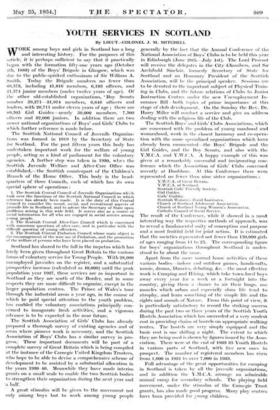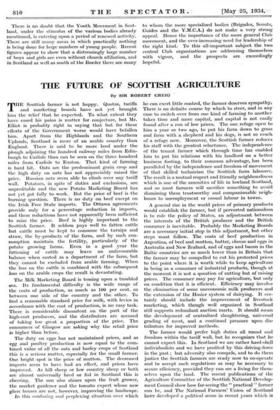YOUTH . SERVICES IN SCOTLAND SERV ICES
By LIEUT.-COLONEL J. M. MITCHELL
• The Scottish -National Council of Juvenile Organiza- tions was formed in 1919 by the Secretary of State for Scotland. For the past fifteen years this body has undertaken- important work for the welfare of young people, acting as a kind of parliament for the voluntary agencies. A further step was taken in 1930, whet the Scottish Juvenile Welfare and After-Care Office was established,L---the Scottish counterpart of the Children's Branch of the Home Office. This body is the head- quarters bf three Councils, each of which has its own special sphere of operations : . •
1. The Scottish Central Council of Juvenile Organizations wh:cli took over the functions of the Scottish National Council to which reference has already been made. It is the duty of this Central Council to consider the moral, social, and recreational aspects of juvenile life in Scotland, and to advise the Secretary of State upon problems arising in this wide field. It serves also as a centre of social information for all who are engaged in social service among young people.
2. The Scottish Central After-Care cpuncil which is concerned with numerous questions of after care, and in particular with the difficult question of young offenders.
3. The Scottish Central Probation Council whose main object is the encouragement of the wise use of Probation, and the promotion of the welfare of persons who have been placed on probation.
Scotland has shared to the full in the impetus which has lately been given throughout Great Britain to the various forms of voluntary service for Young People. With 28,000 uneMplaYed juveniles on the register, and a substantial prospectiVoincrease (calculated as 40,000) until the peak pOpulatiOn year 1937, these services are as important in 'Scotland as they are south of the Border, and in some respects they are more difficult to Organize, except in the larger population centres. The Prince of Wales's tour through the industrial areas a Year ago, in the course of which he paid special attention to the youth problem, has enabled the voluntary associations. prineipally Con- c.Crned to • inaugurate fresh activities;' and a vigorous adVance is to be expected in the near future.
The Scottish Association of Girls' Clubs has already prepared a thorough survey of existing agencies and of areas Where pioneer work is necessary, and-the Scottish AsSociatiOn of Boys' Clubs has a similar survey in 'pro- gress.' These important documents will be part of a complete survey of Great Britain which is being compiled at the instance Of the Carnegie United Kingdom Trustees, who- hope to be able to devise a comprehensive scheme of developirient to be assisted by a substantial allocation in the years 1986-40. Meanwhile they have made interim 'grants on-a small 'settle to enable the tivo .Scottish bbdies to strengthen their organization dnring the next year and *4 'half; • A -great stimulus will be given to the movement not only among boys 'but to work among young people generally by the fact that the Annual Conference of the National Association of Boys' Clubsisto be held this year in Edinburgh (June 29th—July 1st). The Lord Provost will receive the delegates in. the :City-Chambers, and Sir Archibald Sinclair, formerly Secretary • of State for Scotland and an Honorary President of the Scottish Association, will be the principal speaker. Sessions are to be devoted to the important subject of Physical Train- ing in Clubs, and the future relations of Clubs to Junior Instruction Centres under the new Unemployment In- surance Bill—both topics of prime importance at this stage of•club development. On the Sunday the Rev. Dr. Harry Miller will conduct a service and give an address dealing with the religious life of the Club.
• The Scottish Boys' and Girls' Clubs Associations, which are concerned with the problem of young. manhood and womanhood, work in the closest harmony and co-opera- tion with the more specialized organizations which have already been enumerated—the Boys' Brigade and the Girl Guides, and the Boy Scouts, and also with the Y.M.C.A. and Y.W.C.A. A happy example of this was given at a remarkably successful and invigorating con- ference which the Association of Girls' Clubs convened recently at Dunblane. At this Conference there were represented no fewer than nine sister organizations :
Y.W.C.A. of Great Britain.
Y.W.C.A. of Scotland.
Scottish Girls' Friendly Society.
Girl Guides.
Girls' Guildry.
Scottish Wornen's Rural Institutes.
Church of Scotland Adolescent Association.
Church of Scotland Young Women's Association.
Catholic Council of Social Service.
The result of the Conference, while it showed in a most interesting way the respective methods of approach, was to reveal a fundamental unity of conception and purpose and a most fruitful field for joint action; It is estimated that the societies represented not fewer than 150,000 girls of ages ranging from 14 to 25. The corresponding figure for boys' organizations throughout Scotland is under- stood. to be about the same.
. Apart from the. more normal home activities of these various bodies—indoor and outdoor games, handicrafts, music, drama, libraries, debating, Sze.--the most effective work is Camping and Hiking, which take town-bred boys away every year for a week or a fortnight into the country, giving them a chance to air their lungs, use muscles which urban and especially slum life tend to atrophy, and leant something of the simple life and the sights and sounds of Nature. From this point of view, it is particularly satisfactory to record the striking success during the past two or three years of the Scottish Youth Hostels Association which has succeeded at a very modest cost in providing chains of hostels on appropriate walking routes. The hostels are very simply equipped and the 'basic cost is one shilling a night. The extent to which they are being used is shown by figures issued by the Asso- ciation. There were at the end of 1988 35 Youth Hostels in various parts of Scotland, with five new ones in prospect. The number of registered members has risen from 1,000 in 1931 to over 7,000 in 1983.
Full advantage of the great opportunities for camping in Scotland is taken by all the juvenile organizations, and in ' addition the Y.31-.C.A. arrange an admirable `annual' camp for secondary schools. The playing field ;movement, under the stimulus of the Carnegie Trust • grants, has also made goOd progress. Many play centres have been provided for young children. There is no doubt that the Youth. Movement in Scot- land, under the stimulus of the various bodies already mentioned, is entering upon a period of renewed activity. There are still many areas in which practically nothing is being done for large numbers of young people. Recent figures appear to show that a distressingly large number of boys and girls are even without church affiliation, and in Scotland as well-as south of.the Border there, are many, to whom the more specialized bodies (Brigades, Scouts, Guides and the Y.M.C.A.) do not make a very strong appeal. Hence the importance of the more general Club movement, and the ever-increasing need for leadership of the right kind.r To this all-important subject the two central Club organizations are addressing themselves with vigour, and the prospects are exceedingly hopeful.

















































 Previous page
Previous page